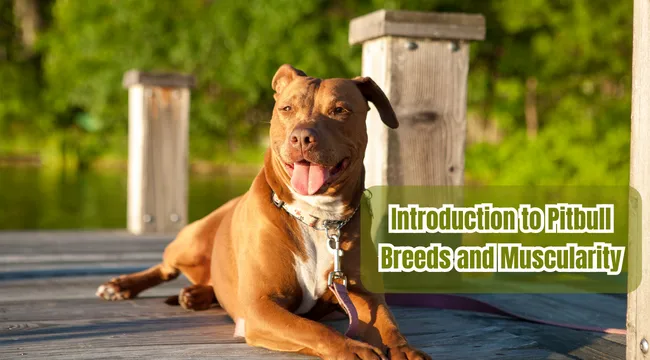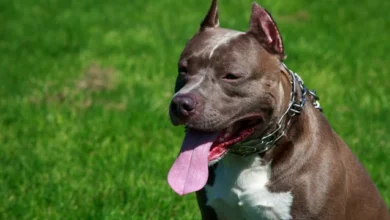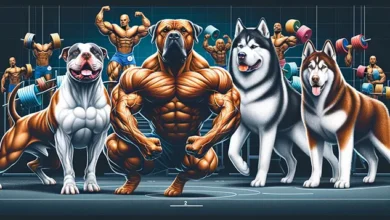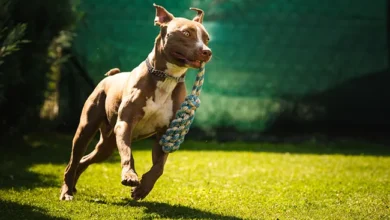
Pitbull breeds, regularly recognized for their power, agility, and muscular construct, have captured the attention and hearts of canine fanatics around the arena. The time period “Pitbull” encompasses quite a number breeds consisting of the American Pit Bull Terrier, the American Staffordshire Terrier, the Staffordshire Bull Terrier, and on occasion the American Bully. These breeds share common trends including a sturdy body, a strong jaw, and a loyal, defensive nature.
The muscularity of Pitbulls is not only a physical attribute however also a key component of their universal fitness and functionality. These puppies were originally bred for activities requiring electricity and staying power, such as farming obligations, guarding, and even as companions in carrying events. Today, their muscular construct is a testament to their background and an important function of the breed’s identification.
Muscularity in Pitbulls isn’t simplest about aesthetic enchantment. It’s a aspect that contributes to their agility, electricity, and average fitness. A properly-muscled Pitbull is often a signal of correct fitness, right care, and effective education. The muscular structure of those puppies enables them to excel in various sports, together with sports activities like weight pulling, agility competitions, and might even make a contribution to their effectiveness as service or remedy dogs.
The purpose of this article is to delve into the arena of Pitbull Muscular breeds, focusing on their muscular build. We aim to discover which Pitbull breed could be the maximum muscular, understand the factors that make a contribution to this trait, and cope with the health and care issues essential for retaining their muscular fitness. By shedding light on those factors, we aim to offer treasured insights for Pitbull proprietors, fans, and all and sundry interested in this fantastic and frequently misunderstood.
Understanding the Pitbull Breed
Origin of Pitbull Breeds
The history of Pitbull breeds is both fascinating and complex. These breeds have their origins in early 19th-century England, where bulldogs and terriers have been crossbred to create dogs that blended the energy of the bulldog with the agility and tenacity of the terrier. Originally bred for bull-baiting and later for ratting and dog fighting, these early pitbulls had been valued for their braveness, physical prowess, and loyalty. The time period “Pitbull” itself is derived from their use in pit preventing sports activities. Following the outlawing of these sports, those dogs gradually transitioned into greater home roles, turning into farm puppies, family protectors, and partners.
Common Misconceptions about Pitbulls
Pitbulls had been problem to severa misconceptions and stereotypes. Common myths include the notion that they’re inherently competitive, have a ‘locking jaw’ mechanism, or aren’t suitable as circle of relatives pets. In truth, Pitbulls, like another canine breed, showcase a number of temperaments inspired by upbringing, education, and socialization. Studies and temperament tests have shown that Pitbulls may be as gentle and pleasant as another famous dog breed. The key to a well-behaved Pitbull, like with all breeds, lies in responsible possession, training, and socialization.
The Role of Genetics in Muscle Development
Pitbulls have been problem to numerous misconceptions and stereotypes. Common myths include the notion that they’re inherently aggressive, have a ‘locking jaw’ mechanism, or are not appropriate as family pets. In truth, Pitbulls, like some other dog breed, show off a number of temperaments inspired by upbringing, schooling, and socialization. Studies and temperament assessments have shown that Pitbulls may be as mild and first-rate as another famous dog breed. The key to a well-behaved Pitbull, like with all breeds, lies in accountable ownership, schooling, and socialization.
Criteria for Measuring Muscularity in Dogs
Before figuring out the maximum muscular Pitbull breeds, it’s critical to recognize the criteria used to measure muscularity in dogs. This includes evaluating muscle mass relative to body length, muscle definition, average body composition, and the dog’s physical electricity and endurance. These factors together make contributions to a canine’s muscularity and are key in assessing the physical developments of Pitbull breeds.
Top Muscular Pitbull Breeds
American Bully: Known for its impressive musculature and strength, the American Bully is a standout in terms of muscular build. This breed displays a bulky body, broad chest, and well-defined musculature.
American Pit Bull Terrier: This breed is admired for its lean, muscular frame. It combines strength and agility, with a well-defined musculature that is evident but not excessively bulky.
Staffordshire Bull Terrier: Though smaller in size compared to its cousins, the Staffordshire Bull Terrier boasts a strong, muscular build. It is compact and well-muscled, displaying strength and agility.
Each of these breeds exemplifies unique aspects of muscularity in Pitbulls, and they all share the common trait of a strong, well-developed physique that reflects their heritage and the careful breeding practices that have shaped them.
American Bully
Physical Characteristics:
- Size: The American Bully is a medium to large breed, characterized by its robust and compact stature.
- Head and Face: They have a broad, blocky head with a short muzzle and distinct cheek muscles.
- Coat: Their coat is short, smooth, and can come in various colors.
Muscular Features:
- Build: The American Bully is renowned for its impressive musculature. It possesses a broad chest, thick neck, and well-defined musculature throughout its body.
- Legs: They have strong, muscular legs that contribute to their powerful appearance.
- Overall Appearance: This breed exudes strength and power through its muscular build, which is more pronounced than in most other Pitbull breeds.
American Pit Bull Terrier
Physical Traits:
- Size: Generally medium-sized, the American Pit Bull Terrier has a well-proportioned body.
- Head: They possess a wedge-shaped head with expressive eyes and well-muscled jaws.
- Coat: The coat is short, stiff to the touch, and glossy, available in a wide range of colors.
Muscularity Aspects:
- Build: The American Pit Bull Terrier has a leaner muscular build compared to the American Bully. Their muscles are well-defined, especially in the shoulders and hindquarters.
- Agility: Their musculature contributes to their remarkable agility and strength, enabling them to perform in various canine sports and activities.
- Overall Physique: They exhibit a balance between muscle mass and agility, which is a defining trait of the breed.
Staffordshire Bull Terrier
Description of Physical Features:
- Size: The Staffordshire Bull Terrier is smaller and more compact than the other Pitbull breeds.
- Head: They have a distinct, broad head with pronounced cheek muscles and a short muzzle.
- Coat: Their coat is smooth and short, coming in various colors and sometimes with patterns.
Analysis of Muscular Structure:
- Build: Despite their smaller size, Staffordshire Bull Terriers have a remarkably muscular and powerful build.
- Strength: Their muscular structure contributes significantly to their strength and tenacity.
- Overall Appearance: The breed’s muscular build is complemented by its fearless and bold demeanor, making it a physically impressive specimen.
Factors Contributing to Muscularity in Pitbulls
Diet and Nutrition
- Balanced Diet: A well-balanced diet rich in proteins, fats, and carbohydrates is essential for muscle growth and maintenance in Pitbulls.
- Supplements: Some owners might include supplements like fish oil or glucosamine to support joint health, especially in muscular breeds.
Exercise and Training
- Regular Exercise: Routine exercise is crucial for maintaining muscle mass and overall health. This includes activities like walking, running, and agility training.
- Strength Training: Specific exercises, such as weight pulling or tug-of-war, can help in developing and maintaining muscle mass in these breeds.
Genetic Factors
- Inherited Traits: Muscle development in Pitbulls is significantly influenced by genetics. Breeds like the American Bully are genetically predisposed to have more muscle mass.
- Selective Breeding: Breeding practices focused on enhancing physical traits like strength and endurance have played a role in the muscular development of these breeds.
By understanding these factors, owners can better care for their muscular Pitbulls, ensuring they lead healthy, active lives.
Common Health Issues in Muscular Breeds
Muscular Pitbull breeds, due to their physical build and genetics, may be predisposed to certain health issues. These include:
- Joint Problems: Conditions like hip dysplasia and elbow dysplasia are more common in muscular breeds. These can lead to arthritis and mobility issues.
- Heart Conditions: Some muscular Pitbulls may be prone to heart diseases such as aortic stenosis or cardiomyopathy, which can affect their overall health and activity levels.
- Obesity: Given their muscular build, these dogs can easily become overweight if their diet and exercise are not properly managed. Obesity can lead to a host of health problems, including diabetes and joint stress.
- Skin Issues: Short-coated breeds like Pitbulls can sometimes suffer from skin allergies and sensitivities, requiring special care and attention.
Preventive Care and Regular Health Check-Ups
Regular veterinary check-ups are essential for maintaining the health of muscular Pitbull breeds. Preventive care includes:
- Routine Examinations: Regular vet visits for physical exams can help in early detection and treatment of potential health issues.
- Vaccinations and Parasite Control: Keeping up to date with vaccinations and routine parasite control is vital for preventing common diseases.
- Hip and Elbow Scoring: For breeds prone to joint problems, hip and elbow scoring can help identify potential issues early on.
- Weight Management: Regular monitoring of weight and body condition to ensure they stay within a healthy range.
The Importance of a Balanced Lifestyle for Muscular Pitbulls
A balanced lifestyle is crucial for the health and well-being of muscular Pitbull breeds:
- Diet: A balanced diet tailored to their specific needs, considering their age, size, and activity level, is vital. It should provide the right amount of proteins, fats, and carbohydrates to support their muscular build.
- Exercise: Adequate exercise is essential not only for maintaining muscle mass but also for overall health. A mix of physical activities, including both aerobic and strength training exercises, can help keep them fit and healthy.
- Mental Stimulation: Mental health is as important as physical health. Activities that stimulate their mind, like training sessions, puzzle toys, and social interactions, can keep them mentally sharp and content.
- Rest: Adequate rest and recovery time is necessary, especially after intense physical activities. This helps in muscle repair and overall health maintenance.
Incorporating these health considerations into the care regimen of muscular Pitbull breeds can lead to a happier, healthier life for these loyal and affectionate companions.
The Role of Responsible Breeding in Muscle Development
- Ethical Breeding Practices: Responsible breeding is pivotal in shaping the health and physical characteristics of Pitbull breeds, particularly in terms of their muscularity. Ethical breeding practices include:
- Genetic Testing: Responsible breeders conduct genetic testing to screen for hereditary diseases and conditions. This helps in making informed breeding decisions to reduce the likelihood of passing on genetic health issues.
- Selective Breeding: Ethical breeders selectively pair dogs based not only on physical attributes like muscle structure but also on temperament and overall health. This approach ensures the well-being of the breed and the individual dogs.
- Avoiding Overbreeding: Ethical breeders avoid overbreeding, which can lead to a decline in genetic diversity and an increase in health problems. They focus on quality, not quantity, in their breeding programs.
- Breeder Education and Standards: Knowledgeable breeders are aware of breed standards and the importance of maintaining the physical and mental health of the dogs. They adhere to standards set by kennel clubs and breed clubs.
Impact of Breeding on Health and Muscularity
The breeding practices have a direct impact on both the health and the muscular development of Pitbull breeds:
- Muscle Development: Selective breeding can enhance certain physical traits, including muscle mass and strength. Breeders who focus on these traits can produce dogs with impressive muscular builds, as seen in breeds like the American Bully.
- Health Risks: While breeding for muscularity, it’s crucial to balance with overall health considerations. Focusing solely on physical traits can lead to overlooking potential health issues.
- Longevity and Quality of Life: Responsible breeding aims at improving not just the physical traits but also the overall longevity and quality of life of the dogs. This means breeding dogs that are not only muscular but also healthy, well-tempered, and adaptable.
- Breed Reputation: Ethical breeding contributes to the positive reputation of the breed. By prioritizing health and temperament alongside physical traits, breeders can help in dispelling myths and misconceptions about Pitbull breeds.
Case Studies: Muscular Pitbulls in Action
Real-Life Examples of Muscular Pitbulls
Presenting real-life examples of muscular Pitbulls provides tangible insights into the breed’s capabilities and characteristics. These case studies highlight individual dogs that have excelled in various fields, showcasing their strength, agility, and temperament.
1. Competition Champions: Featuring Pitbulls that have excelled in canine sports such as weight pulling, agility, or obedience competitions. These stories can illustrate the physical capabilities and training dedication required for such achievements.
2. Service and Therapy Dogs: Highlighting muscular Pitbulls that serve as therapy or service dogs. These examples can demonstrate the breed’s temperament, trainability, and the positive impact they have in assisting people with disabilities or providing emotional support.
3. Rescue and Success Stories: Sharing stories of muscular Pitbulls rescued from challenging circumstances who have gone on to lead happy, healthy lives. These narratives can emphasize the breed’s resilience and the importance of proper care and training.
Insights from Pitbull Owners and Breeders
Gathering insights from those who live and work with muscular Pitbull breeds can provide a well-rounded view of what it’s like to care for these dogs.
Owners’ Experiences: Interviews or testimonials from owners can shed light on the joys and challenges of living with muscular Pitbulls. They can share tips on training, exercise, and maintaining their health.
Breeders’ Perspectives: Breeders can offer valuable insights into the breeding process, explaining how they work to enhance muscularity while ensuring overall health and temperament. They can also discuss the importance of ethical breeding practices.
Veterinarians’ Views: Veterinarians who specialize in muscular breeds like Pitbulls can provide professional insights into common health concerns, preventative care, and nutritional needs.



